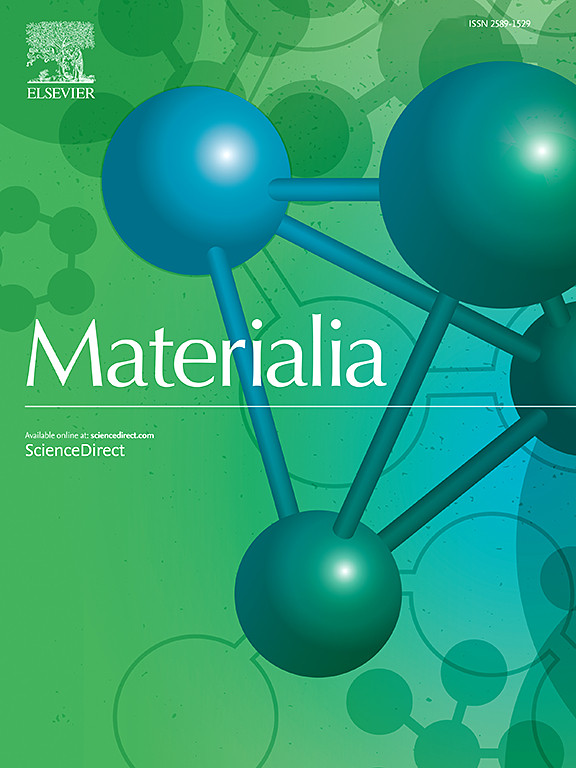巨噬细胞介导的三维人口腔黏膜模型中种植体相关生物膜的控制
IF 3
Q2 MATERIALS SCIENCE, MULTIDISCIPLINARY
引用次数: 0
摘要
巨噬细胞是调节炎症和促进病原体清除的关键,特别是在易发生生物膜感染的种植体周围环境中。为了更好地了解这些免疫细胞在宿主-生物膜-植入物相互作用中的作用,我们开发了一个复杂的三维(3D)植入物-组织-口腔-细菌-生物膜模型(INTERbACT),利用整合的巨噬细胞模拟植入物材料、生物膜和宿主之间复杂的三角相互作用,模拟体内环境。INTERbACT模型包括种植体周围粘膜,胶原包埋成纤维细胞和巨噬细胞,覆盖多层口腔上皮,以及多物种生物膜。组织学分析显示种植体周围结构保存完好,细胞活力高。与多物种生物膜共同培养为巨噬细胞在病原体防御和炎症调节中的作用提供了有价值的见解。在缺乏巨噬细胞的组织中,生物膜暴露导致上皮完整性受损,而含有巨噬细胞的组织保持其上皮结构。巨噬细胞显著降低生物膜生物量,同时促进细菌死亡。在无菌条件下升高的炎症细胞因子水平在生物膜暴露后下降,表明生物膜介导的免疫抑制。细胞因子表达水平与生物膜暴露和巨噬细胞浓度有差异反应,生物膜暴露组织中IL-1β和IL-17水平显著升高,与种植体周围炎症的临床观察结果一致。我们的研究结果表明,巨噬细胞掺入后的INTERbACT模型可作为研究宿主-病原体动力学的生理学相关平台,并可识别与生物膜相关并发症相关的关键炎症标志物。此外,该模型在评估新的治疗策略方面具有重要的潜力,例如用于检测和对抗病原生物膜的传感器-致动器系统,改善种植体周围炎管理的临床结果。本文章由计算机程序翻译,如有差异,请以英文原文为准。

Macrophage-mediated control of implant-associated biofilms in a three-dimensional human oral mucosa model
Macrophages are pivotal in regulating inflammation and facilitating pathogen clearance, particularly in peri-implant environments prone to biofilm infections. For a better understanding of the role of these immune cells in host-biofilm-implant interactions, we developed a complex three-dimensional (3D) implant-tissue-oral-bacterial-biofilm model (INTERbACT) with integrated macrophages to mimic the intricate triangular interactions between implant materials, biofilms, and the host, in conditions simulating the in vivo environment. The INTERbACT model includes a peri-implant mucosa with collagen-embedded fibroblasts and macrophages, overlaid with a multi-layered oral epithelium, as well as a multi-species biofilm. Histological analysis demonstrated a preserved peri-implant architecture with high cell viability. Co-cultivation with multi-species biofilms provided valuable insights into macrophage roles in pathogen defence and inflammation regulation. In tissues lacking macrophages, biofilm exposure led to compromised epithelial integrity, whereas macrophage-containing tissues maintained their epithelial structure. Macrophages significantly reduced the biofilm biomass while promoting bacterial death. Inflammatory cytokine levels elevated under sterile conditions decreased upon biofilm exposure, suggesting a biofilm-mediated immune suppression. Cytokine expression levels differentially reacted to biofilm exposure and macrophage concentration, with IL-1β and IL-17 levels notably elevated in biofilm-exposed tissues, aligning with clinical observations of peri-implant inflammation. Our findings demonstrate that the INTERbACT model, after incorporation of macrophages, serves as a physiologically relevant platform for studying host-pathogen dynamics and allows to identify key inflammatory markers associated with biofilm-related complications. Furthermore, this model holds significant potential for evaluating novel therapeutic strategies, such as sensor-actuator systems to detect and combat pathogenic biofilms, improving clinical outcomes in peri-implantitis management.
求助全文
通过发布文献求助,成功后即可免费获取论文全文。
去求助
来源期刊

Materialia
MATERIALS SCIENCE, MULTIDISCIPLINARY-
CiteScore
6.40
自引率
2.90%
发文量
345
审稿时长
36 days
期刊介绍:
Materialia is a multidisciplinary journal of materials science and engineering that publishes original peer-reviewed research articles. Articles in Materialia advance the understanding of the relationship between processing, structure, property, and function of materials.
Materialia publishes full-length research articles, review articles, and letters (short communications). In addition to receiving direct submissions, Materialia also accepts transfers from Acta Materialia, Inc. partner journals. Materialia offers authors the choice to publish on an open access model (with author fee), or on a subscription model (with no author fee).
 求助内容:
求助内容: 应助结果提醒方式:
应助结果提醒方式:


